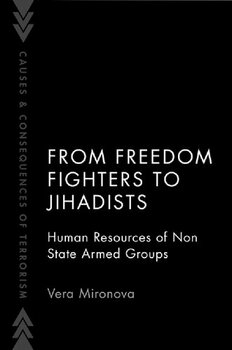
From Freedom Fighters to Jihadists: Human Resources of Non-State Armed Groups PDF
Preview From Freedom Fighters to Jihadists: Human Resources of Non-State Armed Groups
i From Freedom Fighters to Jihadists ii CAUSES AND CONSEQUENCES OF TERRORISM SERIES Series Editors: Gary LaFree Gary A. Ackerman Anthony Lemieux books in the series: From Freedom Fighters to Jihadists: Human Resources of Non-S tate Armed Groups Vera Mironova Published in partnership with The National Consortium for the Study of Terrorism and Responses to Terrorism and the University of Maryland iii From Freedom Fighters to Jihadists Human Resources of Non- State Armed Groups Edited by VERA MIRONOVA Visiting Fellow, Harvard University 1 iv 3 Oxford University Press is a department of the University of Oxford. It furthers the University’s objective of excellence in research, scholarship, and education by publishing worldwide. Oxford is a registered trade mark of Oxford University Press in the UK and certain other countries. Published in the United States of America by Oxford University Press 198 Madison Avenue, New York, NY 10016, United States of America. © University of Maryland 2019 All rights reserved. No part of this publication may be reproduced, stored in a retrieval system, or transmitted, in any form or by any means, without the prior permission in writing of Oxford University Press, or as expressly permitted by law, by license, or under terms agreed with the appropriate reproduction rights organization. Inquiries concerning reproduction outside the scope of the above should be sent to the Rights Department, Oxford University Press, at the address above. You must not circulate this work in any other form and you must impose this same condition on any acquirer. Library of Congress Cataloging-in-Publication Data Names: Mironova, V. G. (Vera Grigor’evna), author. Title: From Freedom Fighters to Jihadists: Human Resources of Non-State Armed Groups / Vera Mironova. Description: New York : Oxford University Press, 2019. | Series: Causes and consequences of terrorism Identifiers: LCCN 2018057012 | ISBN 9780190939762 (paperback) | ISBN 9780190939755 (hardback) Subjects: LCSH: Terrorism—Syria—History—21st century. | Syria—Politics and government—21st century. | BISAC: PSYCHOLOGY / Social Psychology. Classification: LCC HV6433.S95 M57 2019 | DDC 956.9104/231—dc23 LC record available at https://lccn.loc.gov/2018057012 1 3 5 7 9 8 6 4 2 Paperback printed by WebCom, Inc., Canada Hardback printed by Bridgeport National Bindery, Inc., United States of America v This book is dedicated to the memory of all the people who died on all sides of the war in Iraq and Syria. vi vii Contents Preface ix Acknowledgments xvii Introduction 1 1. Armed Groups Human Resource Manual 25 2. Leaving, Staying, Fighting 47 3. Finding a Group That Fits 67 4. Making a Rebel Group Work 85 5. Help from Abroad 101 6. Handling Foreign Fighters 135 7. Handling Ultra- Radicals 173 8. Managing Ideology 209 9. Funding the Fight 229 10. Rebel CEOs and Managers 249 11. Policy Implications 271 Other Conflicts and Ideologies 295 Index 303 viii ix Preface “10 . . . 9 . . . 8 . . . 7 . . . ” An Iraqi Special Operations Forces (ISOF) officer would count back- ward after sending the GPS coordinates for a target building to the air- craft circling above us. The countdown was the ten seconds it took for the building to disappear in a mushroom of dust and enemy fighters to disap- pear under the debris. Once that was done, we would move out of hiding and continue down the narrow streets of the Old City of Mosul, trying hard to be as quiet as possible; the enemy was hiding not only in the destroyed buildings on both sides, but often below in tunnels. As we went, the soldiers casually stepped over the bloated bodies of enemy combatants in their signature uniforms complete with suicide belts. They had been left to rot there for weeks under the hot Iraqi sun, and occa- sionally someone would wonder out loud why those bodies were still there, like they were some kind of abandoned roadblocks. The soldiers considered these once-m en solely as objects, but I didn’t. I saw them from a different angle. These were not stones or fallen trees so inconveniently blocking the way. They used to be people, people who had made decisions in life that brought them to the spot where they lay. At this point I, an academic, had been embedded with ISOF for ten months. I had begun my research on rebel fighters in the Middle East five years prior, and it had led me there, among their lives and deaths, and in close proximity to the organizations that facilitated both. In life, those people had once been part of a feared rebel organization. They had fought, lived and trained in camps, reported to their chain of com- mand, slept on bunkbeds in shifts, and ate in the dining hall on long plastic tables. They lived like those in any other similar institution, except for an Islamic State of Iraq and the Levant (ISIS) twist to some details, like a sign on the door of a camp I once visited. The sign could be roughly translated as, “Dear Brother Jihadists, for everything holy on this planet, please wash the dishes. God bless you.” That made me pause for a second. If fighters did not care about such a mundane thing as doing dishes (that the sign had to
